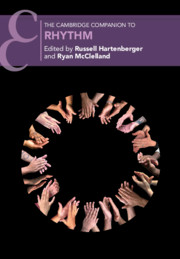Book contents
- The Cambridge Companion to Rhythm
- Cambridge Companions to Music
- The Cambridge Companion to Rhythm
- Copyright page
- Contents
- Figures
- Tables
- Music Examples
- Notes on Contributors
- Acknowledgments
- Introduction
- Part I Overview of Rhythm
- Part II Performing Rhythm
- Part III Composing with Rhythm
- Part IV Rhythm in Jazz and Popular Music
- Part V Rhythm in Global Musics
- 13 The Musical Rhythm of Agbadza Songs
- 14 Rhythmic Thought and Practice in the Indian Subcontinent
- 15 The Draw of Balinese Rhythm
- 16 Rhythmic Structures in Latin American and Caribbean Music
- 17 Indigenous Rhythm and Dance in North and South America
- Part VI Epilogue
- Select Bibliography
- Index
14 - Rhythmic Thought and Practice in the Indian Subcontinent
from Part V - Rhythm in Global Musics
Published online by Cambridge University Press: 18 September 2020
- The Cambridge Companion to Rhythm
- Cambridge Companions to Music
- The Cambridge Companion to Rhythm
- Copyright page
- Contents
- Figures
- Tables
- Music Examples
- Notes on Contributors
- Acknowledgments
- Introduction
- Part I Overview of Rhythm
- Part II Performing Rhythm
- Part III Composing with Rhythm
- Part IV Rhythm in Jazz and Popular Music
- Part V Rhythm in Global Musics
- 13 The Musical Rhythm of Agbadza Songs
- 14 Rhythmic Thought and Practice in the Indian Subcontinent
- 15 The Draw of Balinese Rhythm
- 16 Rhythmic Structures in Latin American and Caribbean Music
- 17 Indigenous Rhythm and Dance in North and South America
- Part VI Epilogue
- Select Bibliography
- Index
Summary
The remarkable facility in rhythmic play demonstrated by musicians and dancers throughout the Indian subcontinent is as impressive as it can be bewildering for the listener. From local and regional practices, through devotional and popular genres, to the heavily theorized concert traditions of the North (Hindustani music) and South (Karnatak music), rhythmic complexity abounds. A performance may begin without even a pulse, where melodies seem to float unpredictably in musical space. Yet increasing rhythmic regularity leads to the establishment of repetitive sequences of beats, both evenly and unevenly distributed, which provide the frameworks for elaborate melodic and rhythmic compositions, variations, and improvisations. The entrance of drums – also essentially melodic in their subtle manipulations of pitch, timbre, stress, and resonance – is invariably a moment of great visceral as well as intellectual excitement. Together, singers, dancers, instrumentalists, and drummers build their performances around the anchors provided by the beats; they subdivide these beats in myriad ways, playing with different rhythmic densities and syncopations. The thrilling, rapidly articulated sequences with their offbeat stresses can temporarily disorient the listener until all seems to resolve in a triumphant convergence of surface rhythm and target beat. The rhythmic system as a whole and the individual frameworks of beats that serve to organize rhythmic expression are known as tala.
- Type
- Chapter
- Information
- The Cambridge Companion to Rhythm , pp. 241 - 260Publisher: Cambridge University PressPrint publication year: 2020



